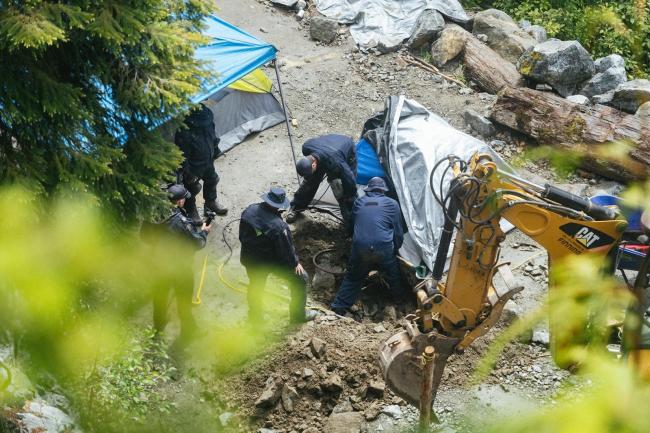Excavator Drivers Horrified by RCMP Methods of Extracting Old-Growth Forest Protectors
June 19, 2021
FOR IMMEDIATE RELEASE:
Two men with experience driving excavators expressed horror that the machines are being used at such close range to people. RCMP have been using excavators to extract numerous old-growth forest protectors from their individual chain-and-concrete blockades at Ada’itsx / Fairy Creek and other sites in the Port Renfrew area.
“It’s just a complete lack of regard for human life,” said Felix Amuir, owner of Amuir Excavating on Gabriola Island. “They’re clearly not seeing them as people.”
Amuir added that if someone operated an excavator that close to anyone on a job site, WCB could shut the site down. “It’s totally crazy what they’re doing. That’s not how anyone should operate equipment.
“If you did something like that on a job site, you’d be uninsurable. If you called my insurer and told them I was doing that, they’d drop me like a hot potato. I’d be done. You can’t risk human life like that.”
A protestor named Joshua, who preferred not to use his last name, said he has years of experience using excavators. The buckets are operated using two joysticks, he explained. Moving one a few centimetres causes the bucket to move feet. “They're not designed to extract people, they’re designed to move rocks. The precision isn’t there.
“It’s just insanely dangerous,” he said. “It’s so not worth the risk. Because if he slips on the joystick in the wrong direction -- just slightly -- that bucket’s over their head. You know what I mean? It’s insane that they would allow that.”
He added he’d seen one video where an RCMP officer, standing beside a protestor, ran from the machine when it moved, while the person on the ground of course could not. “I was just in shock,” he said.
Carole Tootill is a member of the Rainforest Flying Squad grassroots group that started the blockades. She said one recent day at Hayhaka, she and others gasped as she filmed an excavator bucket working just inches from a young woman’s head as she lay on the ground beneath it.
Joshua was unable to find the regulations for safe excavator use in BC, but said Ontario prohibits workers or others from being within the radius of the bucket’s extended arm, plus two additional feet. He added that in some RFS videos he’s seen, the body of the machine is less than four feet from a protestor.
“From the operator station, when they’re digging, they can’t totally tell where the end of the bucket is, relative to a person,” Amuir said. If such close work was required in order to save someone’s life, he added, there would be a spotter on the ground working with the operator. But in the RFS video he watched, no one was doing that, and the RCMP seemed not to be paying attention to the operator or the bucket. “They’re not even going about it in a safe way, if that was a thing you had to do. Which it’s obviously not.”
Reports from protestors arrested yesterday at Eden Camp said they were so close to the excavator they could feel the machine’s weight shifting, compressing their arms, which were locked to cement beneath the earth.
Joshua explained that both machine error and human error can cause accidents, and that the likelihood of human error increases with stress. Any operator in such circumstances, with police and protestors, would undoubtedly be feeling stress, he said. “It’s so easy to have human error, and that would be catastrophic. Even if the ground shifted a little bit.
“The sheer strength of power that’s behind it… “ He expressed disbelief that anyone would use such dangerous equipment so close to a human being. “If you look at deaths in the industry, it’s people working in the vicinity,” he said. “The other thing is that they tip over.”
RCMP have used excavators since about June 7th to extract protestors from the “hard blockades” they sometimes use to slow down police and industry. They are using non-violent methods to protect old-growth forests at Fairy Creek, Camper Creek and several other camps on Pacheedaht First Nations ancestral territory.
When enforcement first started five weeks ago, however, initial extractions were done with jack hammers. RCMP often use "exclusion zones" to keep legal observers and members of the media so far from extractions that they cannot be seen.
Other forest protectors say they have made dozens of concerned calls to WorkSafe BC, but were told they only respond to concerns regarding workers. However, Joshua pointed out that WorkSafe BC’s own website states that the purpose of the Occupational Health and Safety Regulation is to “protect workers and other persons present at workplaces from work-related risks to their health, safety, and well-being.”
Saul Arbess, a spokesperson for Rainforest Flying Squad, the group that began their civil disobedience last August to protect Fairy Creek, said protestors are relieved to hear this confirmation that what RCMP are doing is wrong. “These people don’t deserve to be treated with such utter disregard for their lives and safety,” he said. “They are heroes who are peacefully standing up for these last fragments of ancient forests and all the beings that depend upon them to survive.”
He added that protestors include Indigenous and non-Indigenous people, moms, dads, teenagers, students, teachers, doctors, scientists, forestry workers and many others.
About Rainforest Flying Squad
The Rainforest Flying Squad is a volunteer-driven, grassroots, non-violent direct-action movement committed to protecting the last stands of globally significant ancient temperate rainforest on Vancouver Island. Rainforest Flying Squad works with LastStandforForests and other like-minded organizations, and stands in solidarity with Elder Bill Jones of the Pacheedaht Nation. More information at
laststandforforests.com.
Saul Arbess, RFS spokesperson: 250-383-5878 or 250-686-0764,
sarbess@shaw.ca
